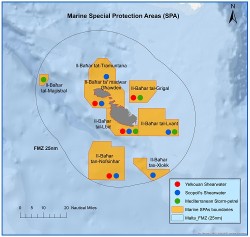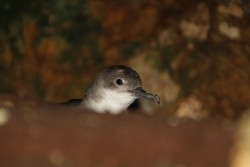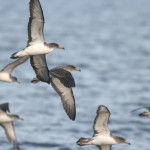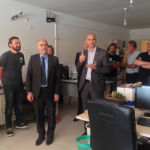Malta now has its first eight marine Special Protection Areas (SPAs) within the Natura 2000 network which gives seabirds in Malta full protection on land and at sea.
Malta’s first marine SPAs were approved by the Maltese Government and their designation as such given the green light by the European Commission. The inventory of these sites was created by BirdLife Malta through its LIFE+ Malta Seabird Project which came to a successful end today with a closing event held at Ċirkewwa.
The eight SPAs now form part of the EU-wide Natura 2000 network which is essential for the protection and long-term survival of Europe’s natural heritage, on land and at sea.
 Throughout the five-year lifespan of this EU funded project (September 2011-June 2016) BirdLife Malta’s researchers identified the most important sites at sea frequented by seabirds known as marine Important Bird Areas (IBAs) and proposed to government that they are legally protected and managed as SPAs.
Throughout the five-year lifespan of this EU funded project (September 2011-June 2016) BirdLife Malta’s researchers identified the most important sites at sea frequented by seabirds known as marine Important Bird Areas (IBAs) and proposed to government that they are legally protected and managed as SPAs.
This will enhance the conservation of all three protected and declining Malta’s seabird species, namely, Yelkouan Shearwaters (Garnija), Scopoli’s Shearwaters (Ċiefa) and European Storm-petrels (Kanġu ta’ Filfla). This is of global importance as the Maltese Islands are home to 10% of Yelkouan Shearwaters’ (Puffinus yelkouan) global population, 3% of Scopoli’s Shearwaters’ (Calonectris diomedea diomedea) and 50% of the Mediterranean subspecies of European Storm-petrels (Hydrobates pelagicus melitensis).
In April, the proposal was adopted – at cabinet level – resulting in Malta having its first declared marine protected areas specifically for birds. Now that these sites have been designated as such, Malta will also be fulfilling its obligation of implementing the EU Birds Directive.
The Birds Directive establishes a network of Special Protection Areas across Europe to protect the natural habitats of endangered and migratory species. All three of Malta Seabird Project’s target seabird species are listed as Annex I species under the Birds Directive. Annex I species are particularly threatened and therefore all EU member states are required to designate SPAs to ensure their survival. Conventionally EU governments designate the SPAs based on IBAs recognised by BirdLife International, as these are scientifically scrutinized findings of key bird areas. Malta is one of the few countries in the European Union to grant legal protection to 100% of its marine Important Bird Areas. Since 1994, all SPAs are also given the status of Natura 2000.
The next step will be the creation and implementation, by the Maltese authorities, of management plans for all the marine protected areas and eventually monitoring them to make sure that seabirds and other marine life are safe and that these areas have Good Environmental Status by 2020 – meaning that they are biodiverse, clean and used sustainably.
The total investment for the LIFE+ Malta Seabird Project was €870,000 half of which was co-funded by the LIFE unit of the European Union. To carry out the project BirdLife Malta teamed up with three other project partners – the Royal Society for the Protection of Birds (RSPB) of the UK, Sociedade Portuguesa para o Estudo das Aves (Portuguese Society for the Study of Birds, SPEA) and Malta’s Ministry for Sustainable Development, Environment and Climate Change who was also a co-financer of the project.
EU Commissioner Karmenu Vella thanks BirdLife Malta and partners for the hard work
 The highlight of today’s closing conference at Paradise Bay Resort Hotel was the official announcement of the SPA designation and a presentation of the project’s findings.
The highlight of today’s closing conference at Paradise Bay Resort Hotel was the official announcement of the SPA designation and a presentation of the project’s findings.
Malta’s Environment Minister Josè Herrera opened the proceedings with his welcoming comments whilst European Commissioner for Environment, Maritime Affairs and Fisheries Karmenu Vella – in a video message – described this project as a cause for celebration and also as a perfect example of the value of collaboration.
He explained that Malta i s a key location with important bird habitats which need protection and which are central to Natura 2000, a network which he described as a vital tool but that can only work if member states play their part. “That is why, back in April, Malta designated eight new offshore sites which the European Union is currently examining to see if they meet expectations, but is delighted to see things progressing. We can learn a lot from this project as it shows the result of combining EU funding with passionate commitment by people who care,” said Vella.
s a key location with important bird habitats which need protection and which are central to Natura 2000, a network which he described as a vital tool but that can only work if member states play their part. “That is why, back in April, Malta designated eight new offshore sites which the European Union is currently examining to see if they meet expectations, but is delighted to see things progressing. We can learn a lot from this project as it shows the result of combining EU funding with passionate commitment by people who care,” said Vella.
The European Commissioner continued that biodiversity loss is a Europe-wide problem and Natura 2000 is a Europe-wide solution. “With the hard work of BirdLife Malta and its partners, the problem is addressed and nature is protected,” he insisted, while appealing for more international collaboration for seabirds to be protected and also mentioning the new LIFE project undertaken by BirdLife Malta, LIFE Arċipelagu Garnija, wishing it success.
Karmenu Vella’s speech was followed by an overview of LIFE+ Malta Seabird Project by Project Manager Nicholas Barbara and a detailed technical and scientific presentation about the work undertaken during the five year term of the project by members of the research team Dr Benjamin Metzger, who led the research work of the project; and Paulo Lago Barreiro who assisted in the finalisation of the IBA identification process.
After a presentation by Margaret Cassar, Director (Policy Development and Programme Implementation) at the Ministry for Sustainable Development, Environment and Climate Change; BirdLife Malta explained the next steps related to the findings of the project.
The conference came to an end with short messages from the project partners, including BirdLife Malta President Darryl Grima’s address.
3 seabird projects in 15 years
The LIFE+ Malta Seabird Project is chronologically the second of three projects related to Malta’s seabirds being carried out by BirdLife Malta and its international partners over a span of fifteen years – all of them co-funded with EU LIFE funds.
The first was the LIFE Yelkouan Shearwater Project (2006 -2010) which focused on the conservation, research and awareness of this seabird species with special focus on the largest colony in Malta at Irdum tal-Madonna in Mellieħa.
-2010) which focused on the conservation, research and awareness of this seabird species with special focus on the largest colony in Malta at Irdum tal-Madonna in Mellieħa.
The LIFE+ Malta Seabird Project (2011-2016) which has now been completed, used extensive and innovative research to identify the most important areas at sea essential for Malta’s seabirds and created an inventory of the marine Important Bird Areas (IBAs) to be legally protected after now being designated as Malta’s first marine Special Protection Areas (SPAs). This second project targeted all three protected species of seabirds in Malta.
The third project, LIFE Arċipelagu Garnija (2015-2020), was launched by BirdLife Malta a few weeks ago and seeks to complement the findings of the first two. By building upon the achievements of the previous projects, it aims at securing the Maltese Islands for the Yelkouan Shearwater. This will be done by identifying and fully understanding the species’ distribution and assessing the specific threats these seabirds face in each nesting site. Then, by directly reaching out to various stakeholders such as fisheries, boat operators, policy makers and the public, the project will encourage a change in their behaviour and thus significantly eliminate the threats caused to these birds.
Read the Maltese version of the press release here.



